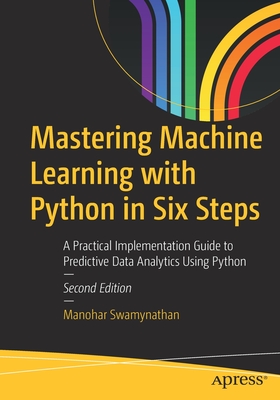Ensemble Machine Learning Cookbook: Over 35 practical recipes to explore ensemble machine learning techniques using Python
暫譯: 集成機器學習食譜:超過35個實用範例探索使用Python的集成機器學習技術
Dipayan Sarkar, Vijayalakshmi Natarajan
- 出版商: Packt Publishing
- 出版日期: 2019-01-30
- 售價: $1,520
- 貴賓價: 9.5 折 $1,444
- 語言: 英文
- 頁數: 336
- 裝訂: Paperback
- ISBN: 1789136601
- ISBN-13: 9781789136609
-
相關分類:
Machine Learning
立即出貨 (庫存=1)
買這商品的人也買了...
-
 Laravel 啟動與運行 (Laravel: Up and Running: A Framework for Building Modern PHP Apps)
Laravel 啟動與運行 (Laravel: Up and Running: A Framework for Building Modern PHP Apps)$780$616 -
 Python 資料科學學習手冊 (Python Data Science Handbook: Essential Tools for Working with Data)
Python 資料科學學習手冊 (Python Data Science Handbook: Essential Tools for Working with Data)$780$616 -
 $294Elasticsearch大數據搜索引擎
$294Elasticsearch大數據搜索引擎 -
 $299深入淺出 SSD:固態存儲核心技術、原理與實戰
$299深入淺出 SSD:固態存儲核心技術、原理與實戰 -
 高性能 Linux 服務器運維實戰:shell 編程、監控告警、性能優化與實戰案例
高性能 Linux 服務器運維實戰:shell 編程、監控告警、性能優化與實戰案例$870$827 -
 $311機器學習基礎 建模與問題求解
$311機器學習基礎 建模與問題求解
商品描述
Implement machine learning algorithms to build ensemble models using Keras, H2O, Scikit-Learn, Pandas and more
Key Features
- Apply popular machine learning algorithms using a recipe-based approach
- Implement boosting, bagging, and stacking ensemble methods to improve machine learning models
- Discover real-world ensemble applications and encounter complex challenges in Kaggle competitions
Book Description
Ensemble modeling is an approach used to improve the performance of machine learning models. It combines two or more similar or dissimilar machine learning algorithms to deliver superior intellectual powers. This book will help you to implement popular machine learning algorithms to cover different paradigms of ensemble machine learning such as boosting, bagging, and stacking.
The Ensemble Machine Learning Cookbook will start by getting you acquainted with the basics of ensemble techniques and exploratory data analysis. You'll then learn to implement tasks related to statistical and machine learning algorithms to understand the ensemble of multiple heterogeneous algorithms. It will also ensure that you don't miss out on key topics, such as like resampling methods. As you progress, you'll get a better understanding of bagging, boosting, stacking, and working with the Random Forest algorithm using real-world examples. The book will highlight how these ensemble methods use multiple models to improve machine learning results, as compared to a single model. In the concluding chapters, you'll delve into advanced ensemble models using neural networks, natural language processing, and more. You'll also be able to implement models such as fraud detection, text categorization, and sentiment analysis.
By the end of this book, you'll be able to harness ensemble techniques and the working mechanisms of machine learning algorithms to build intelligent models using individual recipes.
What you will learn
- Understand how to use machine learning algorithms for regression and classification problems
- Implement ensemble techniques such as averaging, weighted averaging, and max-voting
- Get to grips with advanced ensemble methods, such as bootstrapping, bagging, and stacking
- Use Random Forest for tasks such as classification and regression
- Implement an ensemble of homogeneous and heterogeneous machine learning algorithms
- Learn and implement various boosting techniques, such as AdaBoost, Gradient Boosting Machine, and XGBoost
Who this book is for
This book is designed for data scientists, machine learning developers, and deep learning enthusiasts who want to delve into machine learning algorithms to build powerful ensemble models. Working knowledge of Python programming and basic statistics is a must to help you grasp the concepts in the book.
Table of Contents
- Get Closer to Your Data with Exploratory Data Analysis
- Getting Started with Ensemble Machine Learning
- Resampling Methods
- Statistical & Machine Learning Algorithms
- Bag the Models with Bagging
- When in Doubt, use Random Forest
- Boost up Model Performance with Boosting
- Blend it with Stacking
- Homogeneous Ensemble for Hand-Written Digits Recognition
- Heterogeneous Ensemble Classifiers for Credit Card Default Prediction
- Heterogeneous Ensemble for Sentiment Analysis using NLP
- Heterogeneous Ensemble for Multi-Label Classification for Text Categorization
商品描述(中文翻譯)
**實作機器學習演算法以使用 Keras、H2O、Scikit-Learn、Pandas 等建立集成模型**
#### 主要特點
- 使用食譜式的方法應用流行的機器學習演算法
- 實作提升、裝袋和堆疊集成方法以改善機器學習模型
- 發現真實世界的集成應用並在 Kaggle 競賽中面對複雜挑戰
#### 書籍描述
集成建模是一種用於改善機器學習模型性能的方法。它結合兩個或更多相似或不相似的機器學習演算法,以提供更優越的智力能力。本書將幫助您實作流行的機器學習演算法,以涵蓋集成機器學習的不同範式,如提升、裝袋和堆疊。
《集成機器學習食譜》將從讓您熟悉集成技術和探索性數據分析的基本概念開始。接著,您將學習實作與統計和機器學習演算法相關的任務,以理解多個異質演算法的集成。它還將確保您不會錯過關鍵主題,例如重抽樣方法。隨著進展,您將更好地理解裝袋、提升、堆疊,以及使用真實世界範例的隨機森林演算法。本書將強調這些集成方法如何使用多個模型來改善機器學習結果,相較於單一模型。在結尾章節中,您將深入探討使用神經網絡、自然語言處理等的高級集成模型。您還將能夠實作如詐騙檢測、文本分類和情感分析等模型。
在本書結束時,您將能夠利用集成技術和機器學習演算法的運作機制,使用個別食譜建立智能模型。
#### 您將學到什麼
- 理解如何使用機器學習演算法解決回歸和分類問題
- 實作集成技術,如平均、加權平均和最大投票
- 熟悉高級集成方法,如自助法、裝袋和堆疊
- 使用隨機森林進行分類和回歸任務
- 實作同質和異質的機器學習演算法集成
- 學習並實作各種提升技術,如 AdaBoost、梯度提升機和 XGBoost
#### 本書適合誰
本書專為數據科學家、機器學習開發者和深度學習愛好者設計,旨在深入探討機器學習演算法以建立強大的集成模型。具備 Python 程式設計和基本統計的工作知識是理解本書概念的必要條件。
#### 目錄
1. 透過探索性數據分析更接近您的數據
2. 開始集成機器學習
3. 重抽樣方法
4. 統計與機器學習演算法
5. 使用裝袋法包裝模型
6. 當有疑問時,使用隨機森林
7. 透過提升提高模型性能
8. 使用堆疊進行混合
9. 用於手寫數字識別的同質集成
10. 用於信用卡違約預測的異質集成分類器
11. 使用自然語言處理進行情感分析的異質集成
12. 用於文本分類的多標籤分類的異質集成










